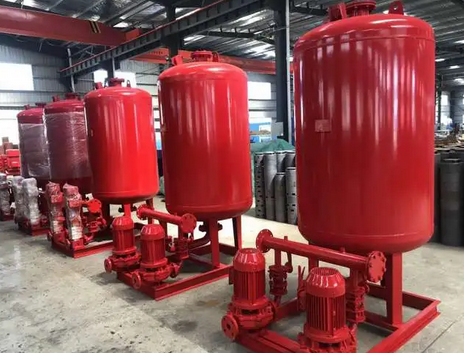How to determine the flow rate of fire-fighting pressure-stabilizing pump
Determining the flow rate of a fire-fighting pressure-stabilizing pump is a process that takes into account multiple factors, mainly based on the specific needs, design specifications, and actual usage scenarios of the fire-fighting system. Here are some key steps and considerations:
1. Understand the needs of the fire-fighting system
System design flow rate: The design flow rate of a fire-fighting system is usually determined based on the amount of water that needs to be sprayed per unit time, in cubic meters per hour (m³/h). This needs to be calculated based on the design requirements and specific usage scenarios of the fire-fighting system, including the flow rate of each nozzle, the number of nozzles, and the spraying time.
Pipeline leakage: The design flow rate of the pressure-stabilizing pump should not be less than the normal leakage rate of the fire-fighting water supply system pipeline and the automatic start-up flow rate of the system. When there is no pipeline leakage data, the design flow rate of the pressure-stabilizing pump should be calculated as 1% to 3% of the fire-fighting water supply design flow rate, and should not be less than 1L/s.

2. Reference specifications and standards
National specifications: my country's current specifications, such as the "Code for Fire Protection Design of High-rise Civil Buildings" (GBJ50045-95) (Note: This specification may have been updated, please refer to the latest version) have clear provisions for boosting facilities (including pressure-stabilizing pumps). For example, the water output of the booster pump should not be greater than 5L/s for the fire hydrant water supply system and should not be greater than 1L/s for the automatic sprinkler fire extinguishing system. However, these regulations have prerequisites and applicable scenarios, and need to be applied flexibly according to actual conditions.
Industry standards: In addition to national regulations, relevant industry standards and local regulations should also be referred to ensure that the selection of fire-fighting pressure-stabilizing pumps meets the requirements of local fire departments.
3. Consider the actual use scenario
System type: When the pressure-stabilizing pump is used in a sprinkler system, the water volume of a sprinkler head needs to be considered; when it is used in a fire hydrant system, the water volume of a fire hydrant needs to be considered. In addition, it is also necessary to consider whether the system is equipped with auxiliary equipment such as air pressure water tanks, which will affect the flow selection of the pressure-stabilizing pump.
Pipe material and diameter: The pipe material and diameter affect the water flow resistance, which in turn affects the flow demand of the pressure-stabilizing pump. Therefore, when selecting a pressure-stabilizing pump, the actual situation of the pipeline system needs to be considered.
System pressure requirements: The design pressure of the pressure-stabilizing pump should meet the requirements of automatic system startup and water filling of the pipe network, and maintain the hydrostatic pressure requirements of the water fire extinguishing facilities at the most unfavorable point of the system in a quasi-working state. These pressure requirements will also affect the flow selection of the pressure-stabilizing pump.
4. Comprehensive calculation and selection
Flow calculation: According to the actual needs of the fire protection system, the leakage of the pipe network, and the requirements of the specification, the required pressure-stabilizing pump flow is comprehensively calculated.
Selection suggestions: When selecting a pressure-stabilizing pump, in addition to considering the flow requirements, it is also necessary to pay attention to whether the pump's head, power, material and other parameters meet the requirements. At the same time, products with stable performance and reliable quality should be given priority, and ensure that they meet the certification and inspection requirements of the local fire department.
Professional consultation: If you encounter complex situations or uncertain factors, it is recommended to consult a professional fire protection engineer or water pump manufacturer technician for guidance and suggestions.




